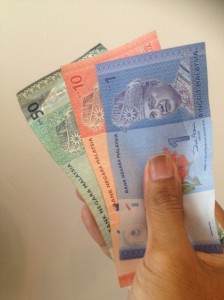With the devaluing of the Malaysian Ringgit, there are certain sectors in Malaysia that may have benefited from it.

The Malaysian Ringgit is the weakest performing currency in the region. Photo: Khalil Adis Consultancy.
By Khalil Adis
As a Singaporean who is often in Malaysia almost every week, I have witnessed first hand the advantages and disadvantages of the falling Malaysian Ringgit as it has declined steadily over the past few months.
From SGD$2.65 to RM1 to a recent high of S$2.8 to RM1 in June 2015, it is indeed music to the Singaporeans’ ears as it means we get more bang for our bucks.
While this is a cause for concern for Malaysians, there are sectors which may have benefitted immensely from the devaluation of the Ringgit.
Advantages
Take the recent June school holidays which coincided with the record low of the Malaysian Ringgit versus the Singapore dollar.
Singaporeans flock to Malaysia in droves to take advantage of the favourable exchange rate for vacations just across the causeway.
This has helped to boost tourism-related industries like food & beverage, hotels, home-stays and short-term rentals.
Even the Vehicle Entry Permit (VEP) imposed on the Malaysian customs has not deterred Singaporeans from going in for quick shopping trips and to wash their cars.
From City Square to KSL, Singaporeans can be seen thronging the malls and the supermarkets during the recent holiday and especially now with Hari Raya around the corner.
Over at the vicinity of New York Hotel in Johor Bahru, businesses along the stretch where car washing kiosks are located at, were brisk as many Singaporean-registered cars can be seen lining up.
In this case, even small to medium-sized enterprises benefitted immensely from the spillover impact from Singapore.
The property sector also saw a marginal boost amid a slow market in Iskandar Malaysia as some Singaporeans took advantage of the favourable exchange rate to purchase properties there.
One particular development located within close proximity to Singapore recently slashed their booking fee from RM10,000 to RM5,000 making it an attractive proposition for investors.
This was indeed a small cheer amid the doom and gloom in the property market as this is one of the few project that has continued to sell well where others saw muted sales.
Even certain projects in the KLCC area saw good take-up rates from foreign investors who saw this as an opportune time to enter the market.
With an average pricing of RM2,500 per sq ft, Singaporean investors snapped up studio units at one particular iconic development located in the heart of KLCC.
When converted to Singapore dollar, you cannot even get a similar property at a prime location in the Lion City.
As Singaporeans and foreigners need to pay state levy in each state when they purchase a property, government coffers from Johor to Kuala Lumpur have received an added boost.
That’s not all
The spillover is also felt in related industries such as law firms, interior design companies and real estate agencies.
Disadvantages
While foreigners and certain sectors in Malaysia appear to be the winners amid the falling Ringgit, Malaysians and foreigners with significant savings in Malaysian banks and exposure to businesses there will be at a disadvantage.
Let me share one scenario
Some of my Malaysian friends have avoided entering Singapore altogether or take a holiday in far flung places as the falling Ringgit means their dollar diminishes when they travel abroad.
Even Thailand is off the radar as the Thai Baht has strengthened considerably against the Ringgit.
As a result, some have opted to do a staycation instead.
In another scenario, a Singaporean friend of mine who does businesses in Malaysia and has a bank account there, sees no point in changing his Ringgit to Singapore dollar as according to him “it’s depressing as I can’t spend that much in Singapore for my day-to-day living”.
What he has done instead is to park his Ringgit in his Malaysian bank account and come back to Singapore to diversify his business.
Foreigners with significant businesses in Malaysia have also reported significant drops in their revenue as the falling Ringgit means it becomes more expensive to procure their services.
One contact of mine who works in the real estate sector said business has been down since early 2015 as Malaysian developers find it expensive when engaging foreign businesses outside Malaysia.
He had to cut staff and hire part-timers instead
Speaking of real estate, consumers buying property will be faced with rising construction costs as some of these materials are sourced from overseas. As a result, developers will then pass on these costs to them.
For those who are thinking of buying a commercial property, you will be hit with a double whammy – GST and rising construction costs.
Even the renovation sector will not be spared as they will pass on the costs to consumers for luxury materials like Italian marble and so on.
Conclusion
So what’s best way to beat the Ringgit blues?
The best hedge against it is to invest in a property and focus on capital appreciation.
I believe that is the best bet for Malaysians right now.
This article was first published by iProperty.com Malaysia in its August 2015 issue.
